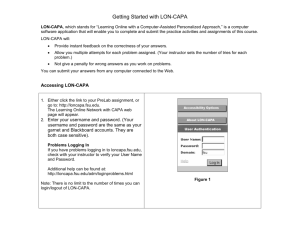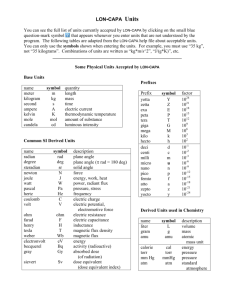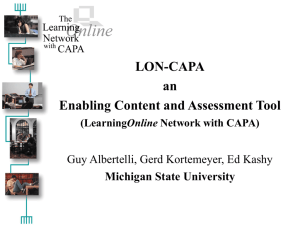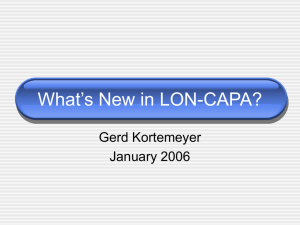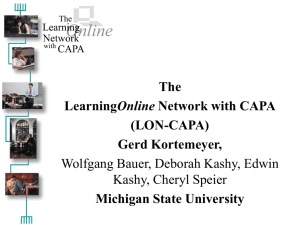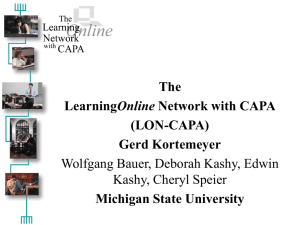Michigan State University
advertisement
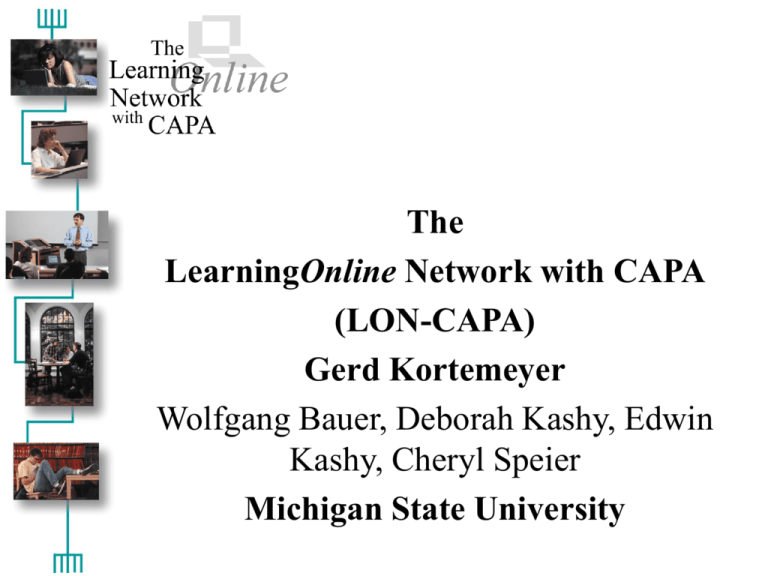
The LearningOnline Network with CAPA (LON-CAPA) Gerd Kortemeyer Wolfgang Bauer, Deborah Kashy, Edwin Kashy, Cheryl Speier Michigan State University What is LON-CAPA? •LON-CAPA stands for LearningOnline Network with a Computer-Assisted Personalized Approach. •developed and implemented by a group of faculty and professionals •provides instructors with a common, scalable platform to assist in all aspects of teaching a course, from lecture preparation to administration of homework assignments and exams •“Distributed Learning Content Management and Assessment System” “Distributed” •LON-CAPA is built as a geographically distributed network of constantly connected servers “Learning Content Management” •Allows instructors to create educational materials and to share such learning resources with colleagues across departments and institutions •All instructional content goes into crossinstitutional shared repository and is cataloged •LON-CAPA provides online tool, “Resource Assembly Tool” (RAT), to combine content into Custom Online Course Pack “Learning Content Management” •Pages can be constructed from fragments and other pages •Sequences can be constructed from fragments, pages, and other sequences •Courses point to (top-level) sequences •Maps at every level are simply other content resources “Learning Content Management” •Graphical resource assembly tool (RAT) to construct maps •Working on branching based on conditions using performance data, course data, and preferences •Individualized curriculum “Individualized Assessment” •Individualized problems: different numbers, different graphs, different options, … •“Classical” online homework types: multiple choice, option response, mix-and-match, string, etc •“STEM” types: numerical, multicomponent numerical, physical units, symbolic math, individualized simulations •Combination of the above types •Adaptive immediate feedback •Multiple attempts “Individualized Assessment” •Example: Individualized graph, numerical answer “Individualized Assessment” •Example: Individualized labels, options “Individualized Assessment” •Example: Multicomponent numerical with individualized animation The Project •“Investigation of a Model for Online Resource Creation and Sharing in Education Settings” •Uses LON-CAPA as model system •Five year project, funded by the National Science Foundation Information Technology Research Program The Project: Research Goals •Open source code development concept for Instructional Management System •Pooling online educational resources between departments, colleges, universities and schools •Business models for “trading” such resources on small level of granularity •Metrics for resource quality and effectiveness •Curriculum adaptivity to learner types and remediation needs The Project: Pilot Users, Boards •Pilot users: 6 high schools, 2 community colleges, 1 four year college, 12 universities •Business advisory board: McGraw-Hill, Saunders, Wiley, Freeman/Worth, Dell, RedHat, Apex Learning, university representatives •Three member Evaluation Board •Four high school teachers in Research Experience for Teachers (RET) supplement The Project: National SMETE Digital Library •Supplement to cross-integrate LON-CAPA with NSF National STEM Digital Library •NSDL available to LON-CAPA as content domain •LON-CAPA resource pool available in NSDL as associated library •LON-CAPA can be used as course delivery tool for NSDL content The Project: Status •Started October 2000 •Two user meetings with 50 faculty from other universities at MSU and Florida State University •Programmer Workshops at MSU in Summer •Eight courses at MSU, approx. 1000 students •Chemistry at Simon Fraser (Vancouver), Physics at Truckee Meadows Community College (Reno). •Three high school courses •Several (internatioal) non-production installations •Active content conversion from predecessor systems www.lon-capa.org Network Architecture: Distribution •LON-CAPA is build as a geographically distributed network of constantly connected servers Network Architecture: Domains •The network is logically divided into domains such as “MSU”, “FSU” or “Publisher X” •Domains limit the flow of user information •Domains can limit access to content resources •Domains limit the extent of user privileges The Tool: Coding Environment •LON-CAPA runs on Linux (target for installs: RedHat distribution) •Apache webserver •mod_perl for server-side handlers •JavaScript for client-side functionality •MySQL as database for metadata searches •MuPAD for symbolic manipulations (planned) Network Architecture: Server Types •Two classes of servers: access servers and library servers •Access servers: host user sessions – processing •Library servers: every user and course has a home server in the network which holds all of their resources and data – storage backend Network Architecture: Load Balancing •Access servers can have a list of spare access servers to offload sessions depending on own work load •Additional round robbin IP scheme possible •MSU setup: msu.lon-capa.org Round Robbin s1 s4 s2 Spares Library Server s3 Network Architecture: Dynamic Replication •When a content resource is first requested, the access server finds the home library server of the author/owner, subscribes to the resource, and copies it in the background. •When resource is modified on its library server, subscribed access servers are notified. •Depending on last date of local access, the access servers copy the new version over, or delete local cached copy. Resources: Handlers •Every resource in the system, both content and system programs, is called by URL – all resources can be bookmarked. •Any resource can be processed on-the-fly while being delivered to the user. •User calls for a resource, LON-CAPA finds appropriate chain of handlers, processes resource for desired target, and sends it out. •Chain of handlers can also cover several transactions. Example: user calls for URL, but needs to login first and then pick course. •All handlers can interact with session environment Resources: Documentdriven processing •Example: user calls for sample.xml sample.xml Uses my.style triggers XML Handler User my.style Defines tags for targets loads Target Session Preferences Environment Resources: XML/MathML/HTML •XML handler provides rendering of XML and HTML to targets XML, HTML, MathML, and LaTeX • Math rendering capability: LaTeX can be inserted into HTML and XML documents between <m> and </m> tags. <h1>Identity</h1><img src=“circle.gif” align=“right”> The <i>identity</i> <m>$\sin^2(\omega t)+ \cos^2(\omega t)=1$</m> allows us to… •Math fragments are rendered into symbol fonts for target HTML, and MathML for MathML-capable browsers using a derivative of tth/ttm. Resources: LaTeX •LaTeX files can be directly put onto the file system, and will be automatically handled as if they had one large <m>…</m> around them Resources: Assessments •“Personalized” by course, user, and instance. •Assessments are XML documents. •Converters for both CAPA and LectureOnline problems exist (functionality superset). •Web-based form editor for these XML documents will be provided similar to LectureOnline. •Code segments within numerical type problems are written in Perl. •Other problem types need no coding. Resources: Publication •Authors have a construction space (private) to edit their resources •Authors can publish their resources into the public resource space •Triggers several actions: generation of a new version (keeping all old versions), collection of metadata for cataloging, notification of all subscribed access servers. Construction Space Publication Step Metadata Resource Space Resources: Metadata •Metadata is collected for every resource at publication time •Publication handler identifies possible keywords, gets default data Resources: Granularity •LON-CAPA RAT allows to dynamically combine content resources at several levels of granularity by reference •Lowest level: fragments. One GIF, one paragraph of text, one applet, one problem •Next level: Pages •Next level: Sequences of pages •Top-level: Maps for Courses (sequences) Resources: Adaptivity •Graphical resource assembly tool (RAT) to construct maps •Allows for branching based on conditions using performance data, course data, and preferences •Individualized curriculum Data Structure: Users •Courses are assigned to users, not vice versa •Users keep their login, data, preferences, etc, throughout complete tenure •Users assume a set of (temporary) roles over their tenure Data Structure: Roles •LON-CAPA has set of roles that can be assigned to users •Roles can have start and end dates Data Structure: Privileges •Each role has a set of privileges •Privileges on system, domain, and course level •Allows for coursecoordinator defined custom roles Data Structure: Courses •Internally, courses are handled like users without login privileges •Each course has a unique ID, no semester transition •Course points to its top-level resource map •Deadlines, spreadsheets, etc, can be associated with the course •Sections are part of course •Homework and quiz performance data is associated with user by course Data Structure: Authentication •Course lists in CSV, tab-separated, and space separated format can be uploaded (planned: XML) •It is checked if the user already exists; if not, new user is established on one of the library servers of the domain •Role of student in that course is added •Users are authenticated by their home server. Authentication can currently be internal, UNIX, or Kerberos. Authentication modular, other modes can be added •All authentication information is 56-bit (DES) encrypted between client and server, and 128-bit (IDEA) between servers. No certificates necessary. Data Structure: Resource parameters •Deadlines, open dates, publish-answer dates, maximum number of attempts, weight of problem parts, etc, can be independently set for courses, sections and individual students •Can cover all resources, one map, or only one resource •Resources publish their parameters in metadata, no predefined set of parameters Data Structure: Locking, Offline •To use LON-CAPA for exams, locking mechanisms will be established: access to resources, all communication can be locked (planned, infrastructure in place) •Role of Exam Proctor in system •To facilitate paper based exams in offline mode, individualized exam sheets can be printed and “checked out” – bar code on top of page to “check in” grades for that exam (planned, infrastructure in place) Data Structure: Assessment data •Only raw data is stored •All attempts are stored •Data is stored in non-randomized form to allow for item analysis •LON-CAPA provides spreadsheet functionality with sheets at assessment, user, and course level (exporting into each other) to calculate grades and statistics On the web ... www.lon-capa.org korte@lon-capa.org
